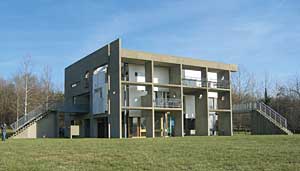The fate of the Miller House, in Lexington, Kentucky, is in doubt after vandals have attacked it. Designed by Le Corbusier protégé José Oubrerie, it has been described as one of the finest residences of the 20th century. Intruders entered the now-vacant property several times this spring and painted graffiti, broke windows, and knocked in much of the plaster. Repairing the damage, Oubrerie estimates, could cost $300,000.

José Oubrerie, second from left in photo, inspects damage inside his iconic Miller house.

The Miller House was finished in 1991 for Robert Miller and his wife, Penny. After her husband passed away in 2002, Penny Miller sold the house in early 2006, as well as 20 acres of land, to Schneider Designs, a local, family-owned residential developer. Oubrerie and enthusiasts of the house fear that the firm will be unwilling to pay for repairs and will eventually demolish it. Calls to Schneider were not returned.
The facades of the Miller House are composed of a thin, cast-in-place concrete screen that wraps around several painted-wood inner structures: One surface is a simple grid of interlocking slabs; another has small vertical and horizontal slits. Inside, the house features an irregular composition of three two-floor living spaces—each with its own bedroom, bath, office, and independent entrance. Built-in cabinetry echoes the facades’ interlocking forms.
“I was bored by normal house planning,” Oubrerie says of his design. “I was interested in exploring my past, and in exploring the city as a house, and the house as a city.” The French architect worked in Corbu’s office from 1957 to 1965 and was the chief designer of Saint Pierre in Firminy, France (featured in the June issue of RECORD). Now a professor at Ohio State University, Oubrerie was dean of the University of Kentucky School of Architecture when he designed the Miller House.
Oubrerie says that the Schneiders failed to activate the property’s security system and have declined offers to pay for its reactivation. “It’s not so much the vandalism, it’s that they let the vandalism happen,” he observes. “I think they want the house to be in as poor shape as possible so they can get rid of it.”
Michael Jacobs, a friend of Oubrerie’s and an adjunct professor at Kentucky’s School of Architecture, is investigating ways to protect the house, including listing it on the National Register. Additionally, he received a pledge of support from the American Institute of Architects during a meeting with its president, RK Stewart, FAIA, in May.
But landmarking a structure takes time, Oubrerie observes, and the house needs protection now. He is trying to raise money to buy the house from the Schneiders. In the meantime, Jacobs has enlisted the help of his students to cover the building’s broken windows with plastic and plywood.


